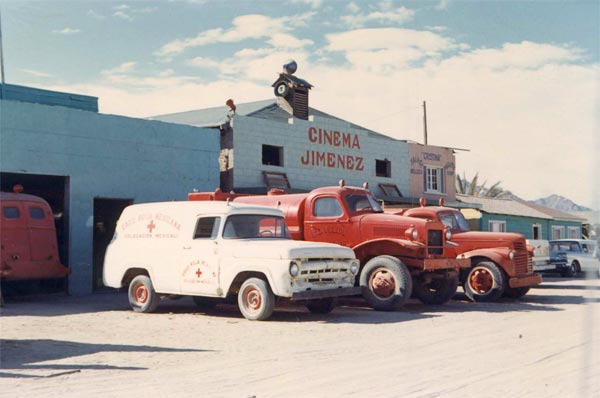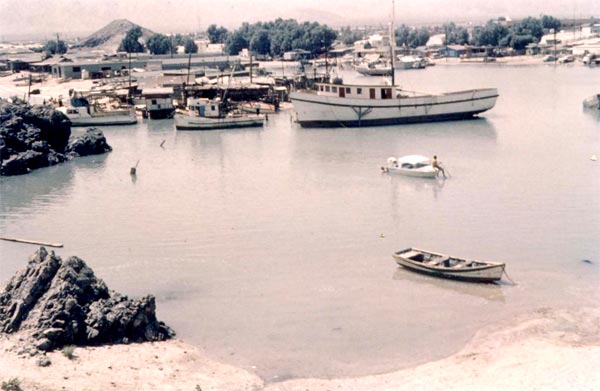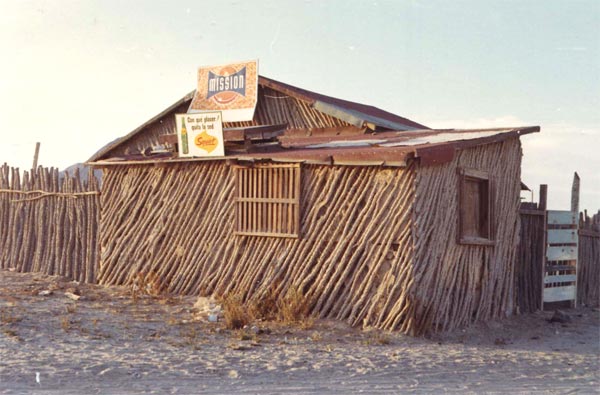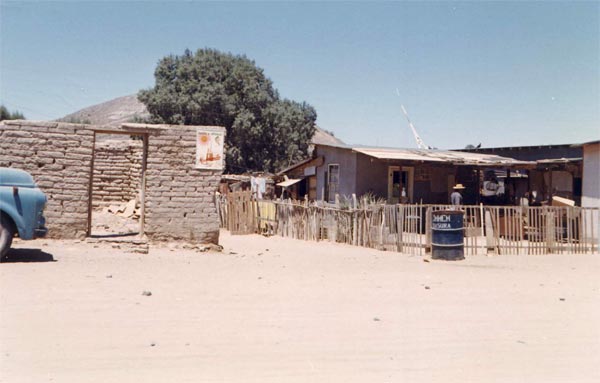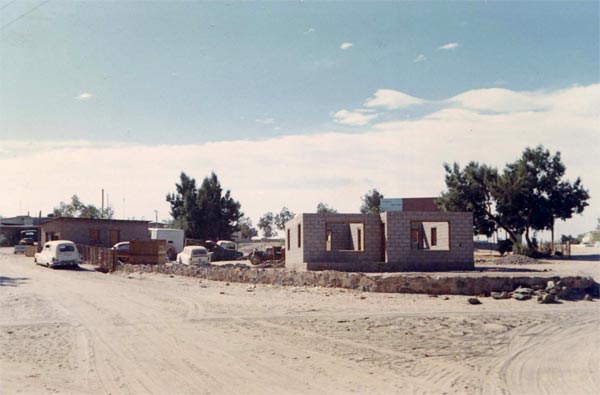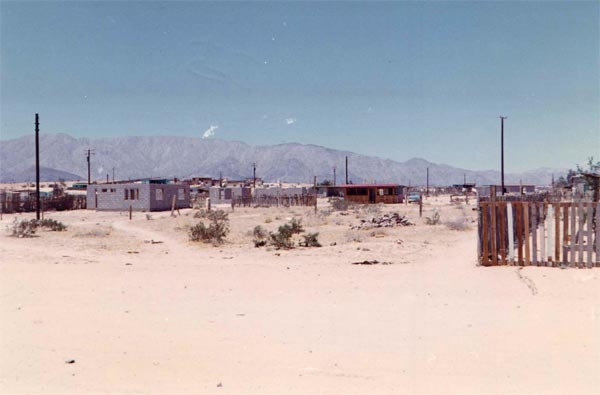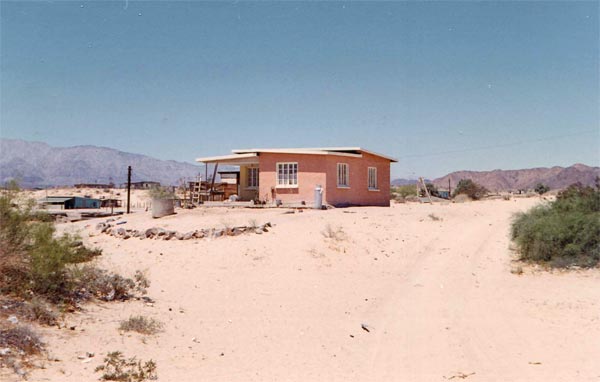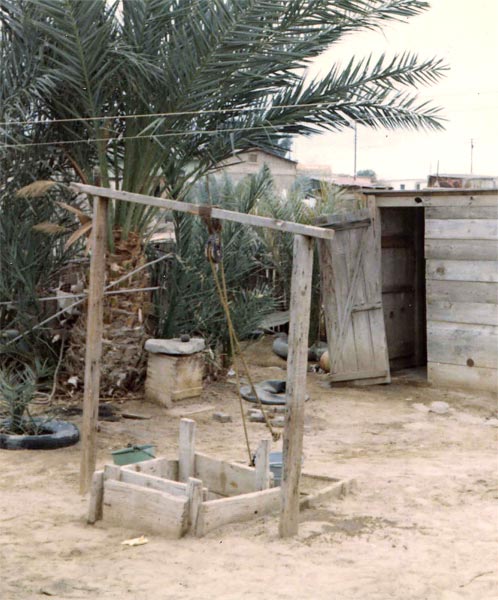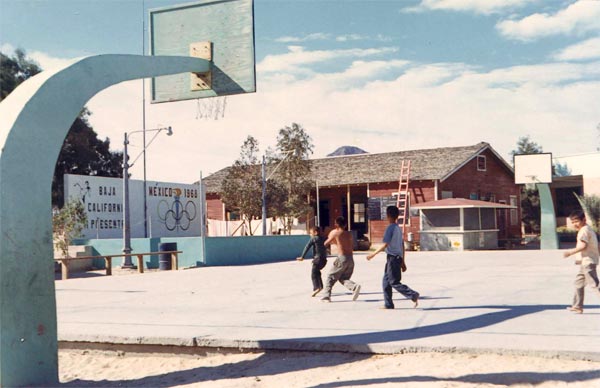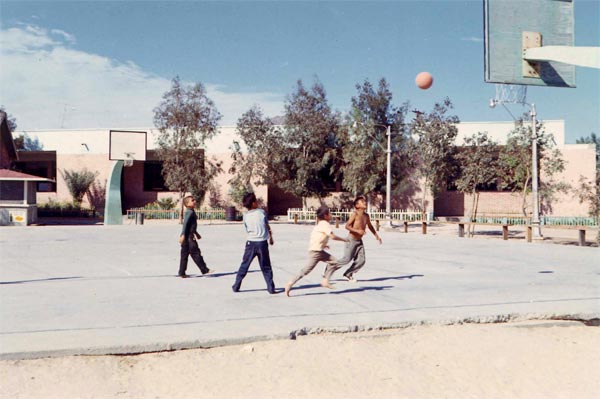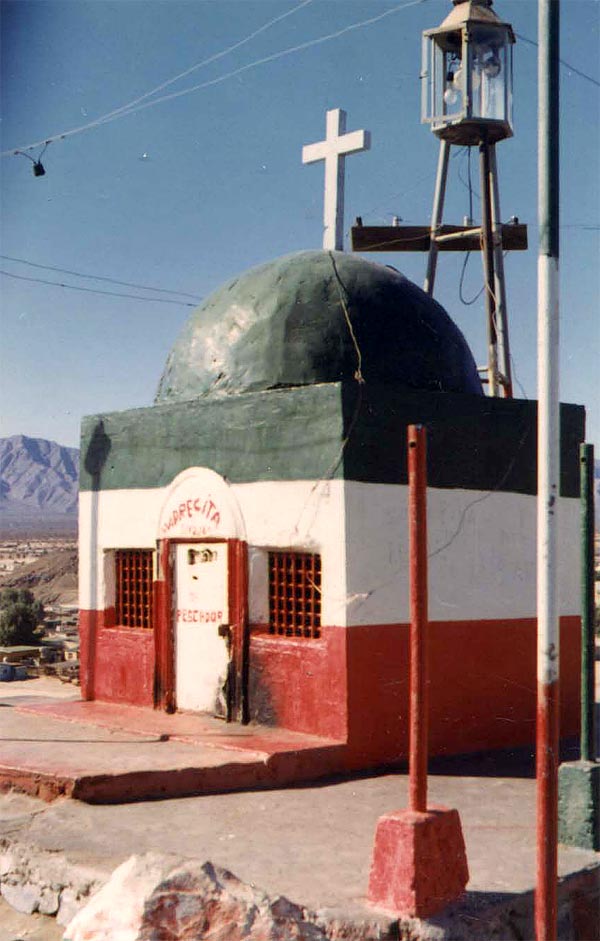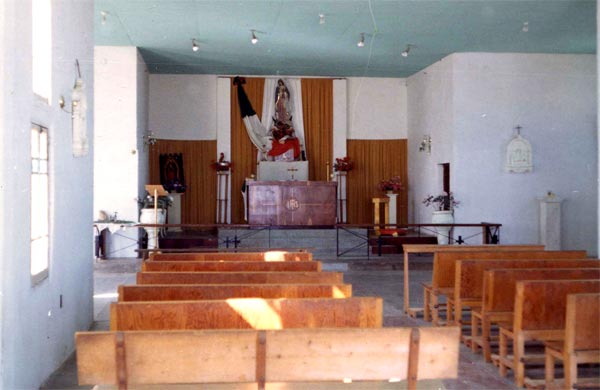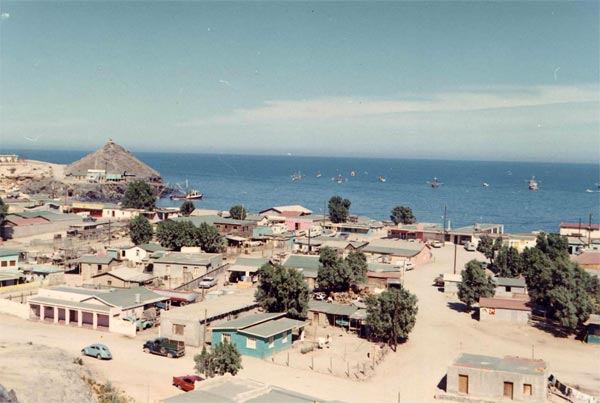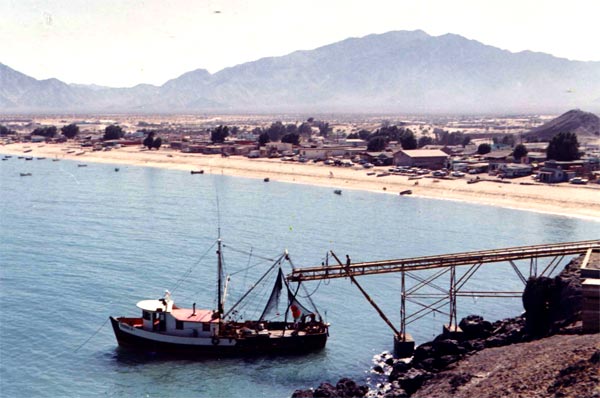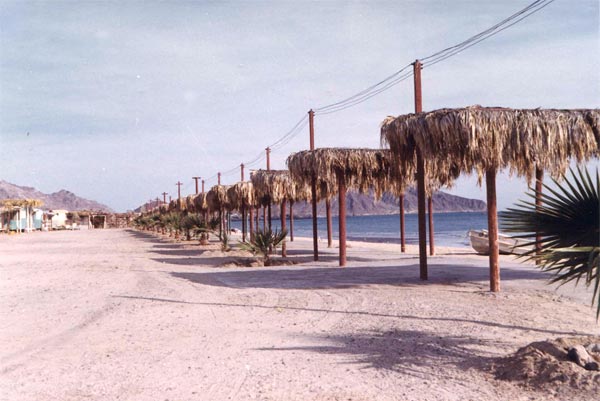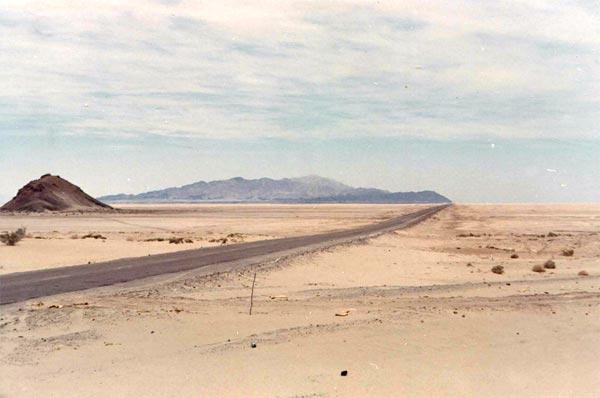
History of San Felipe: Present Day
![]()
THE HISTORY OF SAN FELIPE, BAJA CALIFORNIA, MEXICO
CHAPTER XI: SAN FELIPE TODAY
The field work for this study was completed between 1966 and 1967. At that time the little village hummed with constant activity. New shops and houses were under construction. Unlike their ancient ocotillo predecessors, the new walls were made of cement block and mortar, a definite sign of material progress. The dusty, narrow, main street was heavy with pedestrian and vehicular traffic. A public address system blared with Mexican music, which quickened the pace of the commercial core. The combination of dust, heat, and noise directed one to the nearest cantina for rest and refreshment.
Population. The official 1960 census of population listed San Felipe as a "Pesqueria" (fishing village) with a total population of 2,073, with 1,182 males and 891 females. [VII Censo General de Poblacion 1960 Estado de Baja California. Mexico, D. F. 1963.]
|
Plates 15, 16, and 17. Aerial Views of San Felipe. |
|
Figure 11. Village Pattern and Land Subdivisions. |
Between 1940 and 1950 the village population had quadrupled from 427 to 1700. In contrast, the period 1950 to 1960 saw a general leveling of the population growth trend. During that ten-year period the inhabitants increased their number by approximately three hundred. Reliable estimates of the population today show approximately 4,000 residing in San Felipe, double the 1960 census figure.
Commercial activity. During the time of field work the paved highway to San Felipe came to an abrupt end just inside the limits of the village. San Felipe's main street, as all streets in the village, was an unimproved dirt road. A gasoline station was appropriately located on the corner where the highway and main street of San Felipe intersect. Clearly the majority of commercial activities were found lining the main business street (fig.12).
|
Figure 12. Commercial Street Map of San Felipe. |
The dusty road was flanked by single-story, multicolored shops. Most of the shops were constructed of cement block and stucco. Ubiquitous soft drink and cigarette signs speckle the walls and fences of shops. These signs were also important construction material. Parked in front of the shops were many late-model cars and camper-trucks with California license plates. Few local vehicles were evident. A stand of power poles with street lights lined the east side of the roadway, a familiar sight to the large city dweller (plate 18). Commercial buildings were located along the beach ridge on the east side of the road, formerly an area of houses. A few remaining frame houses were interspersed with the shops. The opposite side of the street was formerly open ground, but in the past fifteen years it has been developed for commercial use. Bars, cafes, and grocery stores made up the largest portion of the village commerce. Most activity along the main street centered on Arnold's Cafe and Meat Market, located centrally on the east side of the main street. This cafe caters to tourist tastes and was the most popular tourist cafe. Besides grocery stores which stocked many other items, the village had reached the population threshold were two pharmacies, one clothing store, and a small furniture store could operate profitably. Most of the shops and grocery stores were quite small but adequate for the village's needs. Grocery store staple canned goods were mainly of United States brands. Fresh meat and vegetables were refrigerated when possible. Major shopping and banking must be done in Mexicali.
|
Plate 18. San Felipe's Main Commercial Street. |
One ambulance, a water truck, and a small fire truck were parked as a sign of community pride in front of the open-face, multi-purpose "Delegacion Municipal" building (plate 19). The old, frame structure served as the police station, fire station, and city hall of San Felipe. Short stretches of cement sidewalks were completely out of line with one another, and consequently seldom used by pedestrians. A second street with some commercial activity was one block west, paralleling the main business section. This street had no lighting and fewer shops. Stores similar to those on the main street lined this one, except an auto parts shop, the only such place in San Felipe.
|
Plate 19. Parked with Pride are San Felipe's Ambulance, Fire, and Water Trucks. |
The bimonthly periods of maximum high tides flood the villages's main street at the north end of town with three to four feet of sea water. San Felipe is well-known for its small tidal lagoon and tourists are often amused at the sight of the flooded area. But to the inhabitants the tidal lagoon will always play a vital part in the village's fishing economy. This flooded area substitutes as a dry-dock facility for boat repairs. The vessels can be moved easily within the circular lagoon at high tide (plate 20). At low tide the area drains, leaving the boats on dry land for necessary repairs. With the arrival of the next high tide the repaired boats are moved out into the bay.
|
Plate 20. The Flooded Tidal Lagoon at High Tide. |
House types. Reconnaissance of the houses of San Felipe revealed that construction materials were varied; brick, cement block, or wood. Desert brush and ocotillo shelters of the past were rare and many old adobe dwellings were empty shells, material illustration of San Felipe's history (plate 21 and 22). Cement block was the most popular building material. Construction was a slow procedure since mortar and blocks must be trucked from Mexicali. Most of the home owners do their own building with the help of neighbors. The men do the construction during off-season fishing periods or when they have time off from fishing. Requested building materials from Mexicali arrive intermittently at San Felipe; therefore, incomplete block forms might stand for months before final completion (plates 23 and 24). Many of the recently completed houses in the village exhibited a neat, clean appearance, a strange sight for such a dusty environment (plate 25).
|
Plate 21. An Old Dwelling at the Village Constructed from Ocotillo Limbs. |
|
Plate 22. Abandoned Adobe Shells give way to Newer Stucco Housing. |
|
Plate 23. Empty Block Forms Stand for months Before Completion. |
|
Plate 24. Cement Block is Now Popular Building Material. |
|
Plate 25. Many Houses have a Surprisingly Tidy Appearance in such a Sandy Environment. |
The outhouse was omnipresent in San Felipe. None of the dwellings had plumbing facilities. Most of the outhouses were constructed of wood and located to the leeward of the houses. All hotels and trailer courts had adequate plumbing; many include showers. These facilities are necessary for tourist comfort. Every dwelling in the village was supplied with electricity by four diesel generators located in the village. Not long ago electrical lighting was a luxury to the villagers, for generators have only been in operation since 1958.
The availability of water was not a problem for the villager. Well water was readily accessible at a depth of five to ten feet in the sand. This water contains a high amount of magnesium and is not pleasing to taste (plate 26). Many of the villagers purchase five gallon decanters of purified drinking water trucked from Mexicali, and use the well water solely for washing. Others in San Felipe were accustomed to the well water, and used it for both drinking and washing.
|
Plate 26. Near Surface Ground Water is Readily Available and Backyard Wells are common. Note the Proximity of the Outhouse. |
Schools. Twenty-five years ago, the Mexican government financed the construction of the first one-room primary school for the villages's children. The small elementary school conducted classes through the sixth grade (plate 27). With further federal aid, a much larger facility has been constructed which offers instruction through the ninth grade, giving the children three additional years of education (plate 28).
The village cannot support schooling beyond the junior high level. In order to acquire a higher education many teenagers have gone to Mexicali; few return to San Felipe.
|
Plate 27. A New Basketball Court Fronts the Old Frame Schoolhouse. |
|
Plate 28. Today There is a Newer and much Larger Addition to the Village School. |
Religion. Catholicism is the dominant religion. The first outward sign of religion that strikes the visitor is a small shrine located at the top of a small volcanic knob that extends into the bay and overlooks the village's fishing fleet. The shrine is dedicated to "La Madrecita del Pescador", the Little Mother of the Fisherman. Here, wives of fishermen place lighted candles in front of the housed statues and pray for the safe return of their husbands (plate 29).
|
Plate 29. A Small Hill-top Shrine is Dedicated to the Fishermen of the Village. |
Above the crow of the roosters was heard the Sunday morning church bells notifying the villagers of the impending Mass. The faithful walked the dusty roads leading to the neat, white-washed church located on high ground in the inland residential district of San Felipe. The church is dedicated to "Nuestra Senora de Guadalupe", the patron saint of Mexico. The church's tidy interior was readily noticed. A number of floodlights illuminated the altar and statues of the saints (plate 30). The wooden pews were readily filled by women and children of the village; the men remained standing indifferently in the rear of the church. Occasionally a wandering dog would enter the church to escape the outdoor sun. Some men took advantage of their nearness to the church's door to exit from the long service. After mass was over the people filed out the doors, happy children running far ahead of the elders. The Catholic priest was the only permanent residing member of the clergy in the village. He lived in a small cement block house adjacent to the church.
|
Plate 30. Tidy Interior of San Felipe's Catholic Church. |
A striking feature of San Felipe was the number of protestant churches in the village. Four are concentrated at the south end of the village. Missionaries come to the village in order to preach and aid the people.
Many villagers had joined protestant churches for practical reasons. [Discussion with Jose Hernandez Limon.] The missionaries also gave much needed medical aid and advice to the poorer inhabitants who could not afford the services of San Felipe's medical doctor.
Fishing economy. San Felipe's protective site and proximity to fishing grounds were recognized and utilized by the early fishermen of the 1900's. The excellent bay's site and situation in conjunction with diligent fishermen have been responsible for the development of a large fishing industry involving hundreds of thousands of dollars annually and employment for a majority of the village's manpower. At the time of this study approximately twenty-five large diesel commercial fishing vessels utilized San Felipe as a year-round home port (plate 31). Many smaller vessels and skiffs concentrated on near-shore fishing and were part of San Felipe's fishing fleet.
|
Plate 31. Off-shore Anchored Fishing Fleet. Note the Shrine on the Hill-top. |
In the early 1960's a combined ice and fuel depot was constructed on a small knoll that projects into the bay (plate 32). At high tide vessels would move under the depot's fuel supply tubes, refuel, and take on ice.
|
Plate 32. Fishing Boats Must Refuel and Take on Ice at High Tide. Water Recedes Beyond the Fueling Station at Low Tide. |
San Felipe's annual shrimp catch has averaged over one million pounds. Most of the shrimp is shipped to the United States via the border station at Calexico. The border station compiles records of annual shrimp crossings that arrive from all gulf ports including San Felipe. When the total shrimp catches are compared to San Felipe's annual catch, it is plain to see that San Felipe has been the gulf's outstanding shrimp port for the past six years. San Felipe has averaged two-thirds of the total catch from all gulf ports (Appendix D).
Shrimp fishing is seasonal in nature. Shrimp prefer cool water and are prevalent in the northern gulf from October through March. During the summer months the shrimp migrate to the cooler southern portions of the gulf. Therefore, the upper gulf experiences a slack in shrimp fishing from June through September as indicated in importation records at Calexico (Appendix E).
It was discovered that most totuava imported into the United States are caught at San Felipe (Appendix F). These fish were shipped to wholesalers in San Diego and San Pedro. The Chesapeake Fish Company of San Diego is a major totuava wholesaler. [Discussion with John Vitalich.] Here the totuava is filleted and sent to restaurants and grocery stores. The Chesapeake Fish Company handles one million pounds of totuava annually. In order to increase consumer sales of the fish in the United States, the company is instituting a radio and newspaper promotional campaign to acquaint the public with totuava.
The owner of the fish company and other interested individuals believe that the Mexican fishermen are over-fishing totuava. [Discussion with Harry Orfanos.] Currently the totuava commercial fishing season is closed only forty-five days out of the entire year, March 31 to May 15. During this period, the totuava are allowed to spawn in the mouth of the Colorado River. The wholesalers claim that the forty-five day closed fishing period is not sufficient time for complete spawning. They believe the closed season should be lengthened before the already-dwindling numbers of totuava become extinct.
|
|
The "Oficina de Pesca" at San Felipe has records of the total annual amount of fish caught by the village's fishing fleet since 1960. Besides the most sought-after shrimp and totuava, the 1966 record for all types of fish caught, listed many species of fish and marine life sold commercially by San Felipe's fishing fleet (Appendices G and H).
Tourism. Fishing, boating, and all other types of water sports, combined with adequate tourist accommodations, has lured approximately 50,000 tourists to San Felipe annually. Tourism is seasonal, beginning in November and increasing until a peak is reached in April. In May, tourism begins to decline. A low is reached in the summer months, because of the oppressive heat.
The ever-growing number of curio, sportfishing, and motorcycle rental shops serve the tourists in San Felipe. Profits from San Felipe's tourist industry attracted many Mexicans. They took up residence in the village and opened shops, motels, and trailer courts. These new residents accounted for a steep upswing in San Felipe's population since 1960. Construction of shops, motels, and trailer courts opened new jobs for the villagers and offered diversification from San Felipe's fishing industry. During the past ten years three large, twenty-to-fifty room hotels have been constructed in San Felipe. Each hotel is air conditioned and has English speaking managers who cater solely to United States tourists. There are four beach side trailer parks on the northern and southern extremes of the village. The largest park can handle up to six hundred trailers. Each trailer space is furnished with water, electricity, and an adjoining palm-covered cabana (plate 33). Concrete driveways to the shore provide boat-launching facilities for the boat owners. Pleasant climate combined with peaceful surroundings and good living conditions have attracted many retired people from the United States to make their winter home at San Felipe. These seasonal occupants have parked trailers in the beach side trailer parks as permanent residences. During the period of fieldwork the village was constantly adding tourist facilities, making life more pleasant for vacationers. Two Mexican patrol vehicles cruised the desolate highway between Mexicali and San Felipe to aid stranded motorists (plate 34). Promoters of tourism in San Felipe hoped to construct service stations and roadside rest-stations along the highway for further tourist convenience. With added facilities and tourist attractions San Felipe hopes to become the Palm Springs of northern Baja California.
|
Plate 33. Trailer Parks and Cabanas on the Beach Attract Tourists. |
|
Plate 34. The Long Desolate Road to San Felipe. |
Problems of the village. With the growth of San Felipe came demand for utilities. Electricity was supplied to the village by four diesel generators. They were installed in 1958, with output far in excess of usage. As a result of growth within the village, the electrical output in 1966 was 600 kw below village needs and evidence indicated that this gap would widen unless more power was supplied.
Many of the inhabitants of San Felipe were concerned by the possibility of greater sub-surface salt water intrusion. Increasing population had placed a heavy strain on the ground water supply, and periodic tests of the water indicated that the salinity rate was slowly increasing. Purified water from Mexicali was a very expensive answer to the impending problem. Villagers hoped to construct facilities in the nearby mountains so that a cheap, plentiful supply of water could be piped directly to San Felipe.
Commercial fishing was the villages's basic industry. Shrimp and totuava have been the money-makers of San Felipe's fishing industry. Fish wholesalers claim that totuava may become extinct if current fishing practices continue. If fish dwindle greatly, the village may loose one-half of its commercial fishing income. If the wholesalers' claims are true, new laws securing a lengthened spawning period must be enacted to insure the continuation of the village's basic industry.
TABLE OF CONTENTS: HISTORY OF SAN FELIPE SITE EVOLUTION, BY THOMAS ANTHONY TERICH
(Related San Felipe articles and reports may be found at Mexfish.com's main San Felipe information page. See weekly fishing news, photos, and reports from the major sportfishing vacation areas of Mexico including the San Felipe area in "Mexico Fishing News.")
MEXICO FISHING INFO SAN FELIPE FISHING INFO "WEEKLY MEXICO FISHING NEWS" FISH PHOTO GALLERY






